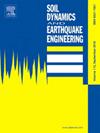A bivariable regression correction method for acceleration integration considering lossless time phases to evaluate the soil cyclic shear behavior in centrifuge tests
IF 4.2
2区 工程技术
Q1 ENGINEERING, GEOLOGICAL
引用次数: 0
Abstract
Using integral displacements from acceleration records, the inversion analysis of soil cyclic shear behavior has been extensively employed in modeling tests and in-situ monitoring of site seismic response. However, there is a lack of attention to the reliability of correction methods for double-integral accelerograms to achieve displacements, especially the phase problem. This might be one of the prime reasons in data processing that lead to non-closure and discontinuity in the hysteresis loops, resulting in significant discreteness in the shear modulus and damping ratio. To address this problem, a novel correction method is proposed using a locally weighted regression function to correct both static parts and dynamic parts in the time domain while integrating acceleration records. The abundant records of paired accelerations and displacements have proved that the phase drift of integral displacements is visibly solved by the proposed method. Meanwhile, the method has high precision in integral amplitudes. The double-integral correction methods have a significant influence on the characteristics and shapes of the hysteresis loops, which is mainly manifested in the phase coordination of shear stress and shear strain. The proposed method can solve the problems of incomplete, discontinuous, and irregular hysteresis loops caused by data processing. The inverse analysis of the shear modulus and damping ratio by the proposed method is less dispersive, which is consistent with the established patterns of what is already known and the results of existing studies. The proposed method is of great theoretical importance and application value to improve the accuracy of the cyclic shear stress-strain response of soils.
考虑无损时相加速度积分的双变量回归校正方法在离心试验中评估土的循环剪切行为
利用加速度记录的积分位移反演土体循环剪切特性,已广泛应用于模拟试验和现场地震反应的现场监测。然而,对于双积分加速度计实现位移的修正方法的可靠性,特别是相位问题,却缺乏足够的重视。这可能是数据处理中导致迟滞回路不闭合和不连续的主要原因之一,从而导致剪切模量和阻尼比出现明显的离散性。为了解决这一问题,提出了一种利用局部加权回归函数对时域静态部分和动态部分进行校正的方法,同时对加速度记录进行积分。大量的成对加速度和位移记录证明,该方法可以明显地解决积分位移的相漂移问题。同时,该方法具有较高的积分振幅精度。双积分修正方法对磁滞回线的特性和形状有显著影响,主要表现为剪切应力和剪切应变的相位协调。该方法可以解决由于数据处理引起的不完全、不连续和不规则的磁滞回的问题。本文提出的方法对剪切模量和阻尼比的逆分析具有较小的色散性,这与已知的既定模式和已有的研究结果相一致。该方法对提高土体循环剪切应力-应变响应的准确性具有重要的理论意义和应用价值。
本文章由计算机程序翻译,如有差异,请以英文原文为准。
求助全文
约1分钟内获得全文
求助全文
来源期刊

Soil Dynamics and Earthquake Engineering
工程技术-地球科学综合
CiteScore
7.50
自引率
15.00%
发文量
446
审稿时长
8 months
期刊介绍:
The journal aims to encourage and enhance the role of mechanics and other disciplines as they relate to earthquake engineering by providing opportunities for the publication of the work of applied mathematicians, engineers and other applied scientists involved in solving problems closely related to the field of earthquake engineering and geotechnical earthquake engineering.
Emphasis is placed on new concepts and techniques, but case histories will also be published if they enhance the presentation and understanding of new technical concepts.
 求助内容:
求助内容: 应助结果提醒方式:
应助结果提醒方式:


